How the Caisse’s Light Rail System will Crumble under its own Weight
May 18th, 2016 by ant6nA second, more sobering look at the Caisse’s “REM†proposal to replace the Deux-Montagnes Commuter Rail line with an extended light rail line: how the Caisse had good ideas but is executing it badly, which will cause trains to be overcrowded from day 1.Version française
Update (2016-10-09): This analysis includes a couple of simplifying assumptions based on the little information provided by the Caisse at the time. For those interested in a more deep analysis included the information that was made available at the BAPE, refer to my memoire, section 4 (for capacity of the Deux-Montagnes line), and section 6.2.1. (Impact on existing Mascouche line). Note the ridership study revealed the St-Anne branch will have the same ridership as the existing Vaudreuil-Hudson line. The St-Jerome line connection may have been dropped from the plans.
The Caisse’s REM-line light rail proposal seems to have elicited two main types of responses: those who are excited Montreal will have great new, modern, efficient transit system, and the skeptics who feel the Caisse is taking us for a ride. My initial reaction put me in the first camp, a deeper look makes me doubtful that light rail is the right way to go.
What is Light Rail, Anyway?
Despite its apparent specificity, “light rail†refers to a range of technologies, from streetcars and trams to systems closer to a metro. This is in contrast to “heavy railâ€, which is defined by the American Public Transportation Association as an electric railway with the capacity to handle a heavy volume of traffic.
The critical detail here is that “light†or “heavy†refers to capacity, not weight.
Weight-wise, if we look at the weight per car, some existing light metro systems similar to the REM have vehicles that are actually heavier than the Montreal Metro. Some are as heavy as the Deux-Montagnes commuter train cars:
Of course, since there are fewer cars, the overall weight for the whole train is naturally lower. However, the train will not run faster! The REM will be electric and will use electric-multiple-unit (EMU) trains like the Montreal metro or the Deux-Montagnes trains. EMUs have no locomotive in the front to pull the whole train. Instead, the motors are evenly distributed throughout the train and every section pulls itself.
A half-length train has half the motors: half the power to move half the weight. Mathematically, you end up with the same speed.
In any case, the REM is definitely “lighter†in terms of capacity. The Caisse envisions 4 car trains during rush hour (2 cars outside of rush-hour), which is half the length of a regular Montreal Metro and a third of the trains on the Deux-Montagnes line.
How much Capacity does the REM Have?
A transit system’s capacity is calculated by multiplying the capacity of each train by the number of trains per hour. This gives us the the number of “passengers per hour per direction†(PPHD).
The REM can carry 600 people per train, and will have a peak frequency of 3 to 6 minutes in the trunk segment (10 to 20 trains per hour), which gives a planned peak capacity of 6000 to 12,000 PPHD.
Compare that with the capacity of the Deux-Montagnes line: about 4 trains per hour during rush hour, with 2000 people per train. Capacity: 8000 PPHD.
From this angle, the REM looks pretty good. Going from 8000 to 12,000, that’s a 50% increase of capacity!
Not so Fast!
We just made a rough comparison with only one of the existing lines. But how much capacity do we actually need?
If we look at the network, the REM will need to provide the capacity of four (!) existing commuter rail lines during peak hours.
As such, it will:
- Replace the Deux-Montagnes line, which it was designed to do;
- Replace the Mascouche line for the Mount Royal tunnel stretch, as the Mascouche trains will no longer go through the tunnel (new technology for the REM in the tunnel is incompatible with the Mascouche trains). The Mascouche line will therefore terminate at the creatively named “A40 station”, where riders will transfer to the REM.
- Replace most of the Vaudreuil-Hudson line, which serves the West Island up to St-Anne-de-Bellevue, and a bit beyond that. West Islanders have been asking for improved service on that line for many lines, or some sort of replacement with better service. This is what the REM provides via its West Island branch.
- Transport passengers from the Saint-Jérôme line who will transfer to the REM at the newly-built Canora station to reach downtown 20 minutes earlier.
So how much capacity do these four commuter lines have today?
The graph below shows the capacity of the REM versus the four commuter rail lines and the Orange Line throughout the day.
We see that the current commuter lines have a combined morning peak capacity of around 25,000 PPHD, and that the peak is, well… very peaky: the network needs to move a huge number of people during the morning rush hour around 8:00. During the rest of the day, the commuter rail lines provide little service, because they are not all day frequent transit. REM on the other hand will provide all-day frequent service, but not enough capacity during the peak. Compare this to the Orange Metro line, which has all day frequent service, but can yank up the capacity during rush hour to almost three times what the REM line will offer, much more than all of Montreal’s commuter rail lines combined.
The REM marketing material boasts a 50% daily capacity increase, but that’s pretty useless for those who need to use it during the hour between 7:30 and 8:30. That’s when most people need to get to work, and they’re not going to change their work schedule just because the REM can’t handle the traffic.
And this is just the current situation, and just the existing commuter rail lines. We are not considering the added demand that will be generated by the REM as more people ditch their cars or slower bus lines for the more convenient rail system. Or the people along the Blue Line who will have a much more convenient route downtown.
What does that Mean in Practice?
1. Train overcrowding
It’s rush hour. On the Deux-Montagnes line, between 8:00 and 9:00, more than 7000 people need to get to work. The Deux-Montagnes branch of the REM will have a frequency of at most 6 minutes, which provides a capacity of 6000 PPHD. That’s already 1000 below what’s needed. Trains will be super full, people will have to wait.
Quick aside: you didn’t think 3 minutes at peak was for the entire network, did you? Nope, that’s only for the trunk stretch, where the trains from the different branches merge together.
The West-Island branch will probably run at, or close to, its max capacity of 6000 PPHD, since it provides a much more convenient alternative to the Vaudreuil-Hudson line for many West Islanders (current capacity: 7500 PPHD).
As the trains go through the downtown stations, they will have to take on all the commuters transferring from the Mascouche line (3000 PPHD). Indeed, the line, which currently goes directly downtown through the Mount-Royal Tunnel, will terminate at the REM because it won’t be compatible with the new rail system they’ll put in the Tunnel for the REM.
The REM will also have to take on the people who will choose to transfer from the St-Jérôme line at the new Canora transfer station, since this will allow them to reach downtown 20 minutes faster.
At any rate, the REM needs double its planned capacity just to transport the current commuter line riders.
Which brings us to our next point:
2. Platform overcrowding
At the “A40†transfer station, each train coming from Mascouche can offload up to 2000 people. These commuters will have to wait in line to squeeze onto the already-full REM. Given that the platforms in the REM stations will be 80m long (less than 30% of the length of the commuter train) and built for trains that carry 600 passengers, it’s not clear where and how long these people will have to wait.
Further along, the riders from the St-Jérôme line will also arrive in batches of 2000 people per train, who will wait even longer to squeeze into even fuller trains. Considering how crowded the trains are, they may choose to stay on their train and continue on their existing commutes.
You might think you’re one of the lucky ones who live far enough to be the first on the train and maybe even get a seat. But the after-work commute is the great equalizer, and you’ll be stuck waiting on the platform with all 3 branches’ riders going home. And since there are only two stations in downtown, each only 80m long, it will be like pushing towards the stage at a pop concert.
3. Passengers overflowing into the Metro
The REM proposal will have a new transfer at Canora that allows commuters on the St-Jérôme line to go downtown via the REM. This would be great to relieve the Orange Line, as many riders transfer today at De la Concorde. Unfortunately, due to the low capacity, commuters will probably keep using the crowded Orange Line.
Worse yet, the Caisse’s plan includes an ‘improved connection’ at Sauvé, which will allow more passengers from the Mascouche line to transfer to the Orange Line. This may be part of the Caisse’s plan to relieve some of the pressure on their own system, as Mascouche riders may prefer to transfer at Sauvé instead of the crowded “A40” REM station.
Given all the above, there also won’t be enough capacity on the REM for people to transfer at the proposed Édouard-Montpetit station from the Blue Line for a direct connection downtown. Since the station is labelled only as a ‘potential station’, chances are it will not be built at all. So instead of transferring onto the REM line, Blue line riders will continue using the Orange Line to get downtown.
In effect, instead of relieving the most overcrowded section of the most overcrowded line in Montreal, the REM line will instead be dumping more passengers onto it.
“Just run it every 60 Seconds!â€
The capacities we just calculated already use the maximum frequencies quoted in the proposal (every 3 minutes on the trunk line). It is unlikely that we could run significantly more trains on the network as it is structured, since the 3-minute frequency is so close to the maximum theoretical capacity of the system.
The Caisse plans to build 80-metre-long stations, so trains can only be that long. Therefore, the only way to provide enough capacity to absorb just the existing commuter rail lines, without even considering the transfers from the Blue Line or any added demand, is to run the trains at 90 second frequencies.
This is double the proposed maximum frequency (and I repeat: just to absorb the existing traffic!), and poses problems on many levels:
The proposal includes an initial order of only 200 train cars (every peak-hour train will be composed of two of these). Even operating all of them would only allow 135 second frequencies, assuming the most optimistic travel times on the whole line (this is based on adding the total the minimum travel times of all the branches, adding a bit of turn-around time, and dividing by having 100 2-car trains, assuming 10% spares).
Even if they were to order more trains, it would be extremely difficult to have 90 second frequencies.
The highest frequency line in Canada is the trunk line of the Expo and Millennium lines, 108 seconds. Once you reach that level, every extra second gets harder, as the time between trains has to be longer than the time the train takes to enter the station, stop at the station and leave the station, plus padding for safety, plus padding to allow maintaining the schedule.
Since there will be very few REM stations downtown and the trains will be very full, there will be a lot of people getting off at each station. The trains will have to wait longer for people to get in and out, especially since the small stations won’t be able to deal well with all that crowding.
Moreover, 90 second frequencies are extremely hard to sustain for long periods of time, as the system needs to run like clockwork. Any delay will cascade through the system, because the distance between the trains will be too small to adjust or catch up to their schedule.
But the really scary constraint is the Mount Royal tunnel. If we run trains every 90 seconds, there will be up to 3 trains in the tunnel at the same time. If something goes wrong, the middle train will be stuck in the tunnel. That’s a bad idea, because there are no emergency exits in-between stations.
In order to safely run trains through the Mount-Royal tunnel, a frequency of 120 seconds will make sure no more than 2 trains are in the tunnel at any time in a given direction and will allow enough padding to sustain a regular schedule without cascading delays.
However, given the short trains, 120 second frequencies mean we will still have a peak capacity shortage of 6000 passengers per hour, or 50%, just to absorb the existing commuter rail traffic!
Basically, even stretching the system beyond its planned limits will not give us enough capacity to add a single new passenger!
For Some, the new Train means Going back to the Car
For all the good points outlined in my previous post, it seems that, unfortunately, the REM falls short on the most important aspect: actually getting everyone from point A to point B.
For commuters, who will be the biggest users, the REM is disappointing. Instead of getting a fast, efficient and modern system, we are looking at stuffy commutes on overcrowded trains. Seating capacity may be slightly better than the Metro, but it certainly will be worse than today’s commuter trains and will mean standing room only for more than half the people on each train.
In the marketing material of the REM project the Caisse announces “a new mode of transportation†and a “a new way of lifeâ€, to fix the “saturated and limited systemâ€. And how does the Caisse plan to solve our transit problems? With wifi, platform screen doors and air-conditioning everywhere, to entice drivers to switch to public transit!
The Caisse needs to seriously ask itself how it can expect drivers to actually switch to their new system, when there’s barely enough capacity to carry the current passenger load. In fact, current train riders might ditch transit altogether!
I don’t think it’s a stretch to believe that the Caisse may be tempted to institute higher fares, higher than the normal Metro fare you’d expect, in order to discourage ridership and bring it in line with the built capacities. After all, the Caisse is a retirement fund and wants to make money operating this line. Higher fares would be great for that – the Caisse can build the line with lower capacity than needed, then charge higher fares until those who are not willing to pay find other ways to get to work. The Caisse will end up with more money, a system running at an efficient capacity, and the public will have received less transit than what they were sold (construction cost will be shared between the Caisse and the public).
Why the Caisse is in Love with Light RailAnd you Shouldn’t be
So why would the Caisse want to tear down a whole electrified transit line and rebuild it entirely, using trains that have less than a third of today’s length? The answer can be found if you look at their previous projects. It seems the Caisse wants to simply replicate the success it had in Vancouver with the Canada Line, ignoring glaring issues like the capacity problems.
The Canada Line is a fully automated light metro line that runs from downtown Vancouver, through a tunnel, then splits into two branches: one going to the suburb of Richmond, and the other going to the airport. It uses very ‘light’ rail: the trains are only 2 cars (40m) long. The line relies on automation and high frequency to compensate for the small train length, just like the REM. Overall it works well and has sufficient train capacity, but the very short stations are already causing platform crowding issues, even though passengers are spread across many stations where they can start and end their journey.
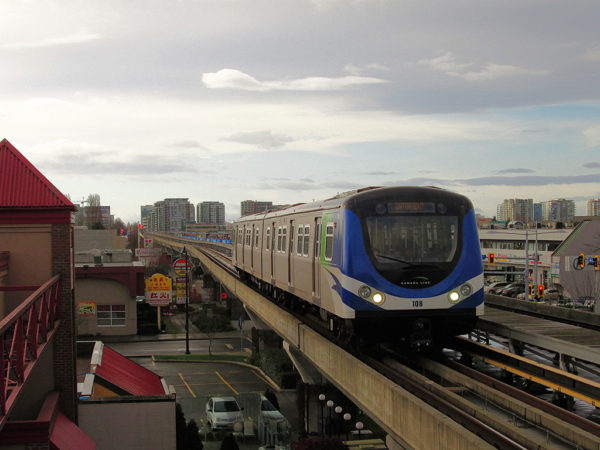
Vancouver’s Canada Line, the Caisse’s role model for the REM. Photo by Stephen Rees, source.
While the Canada Line works well enough for one single line in Vancouver, it is grossly inadequate for Montreal, where it’s supposed to replace an entire network.
Given the scale of the project and the amount of money that will be invested in it, it would make more sense to build a system that is future-proof and could be eventually scaled up to much higher capacities, rather than a system that will already be beyond capacity from day one.
I hope the Caisse will rethink their choice to build a light metro, and, instead, opt for a technology with higher capacity, that can integrate with the existing lines, and that we can expand later.
And we the public, who still have to pay for half the project, and who will be stuck riding it afterwards, should hold them to that.
Thanks to JC for her help in writing the article.
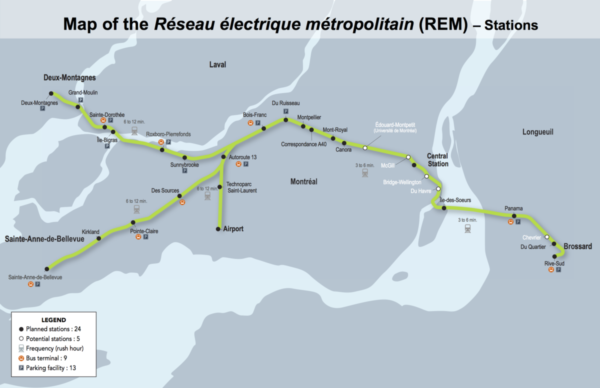
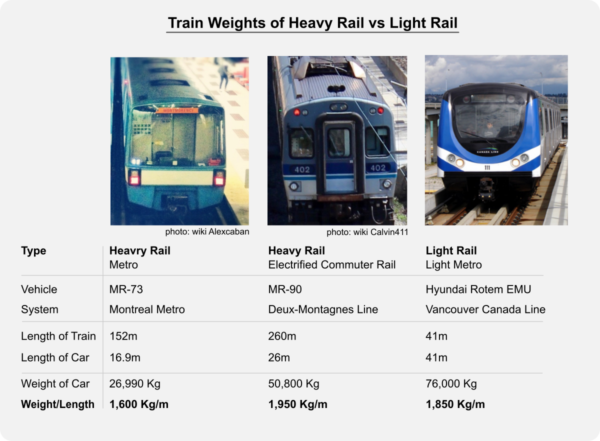
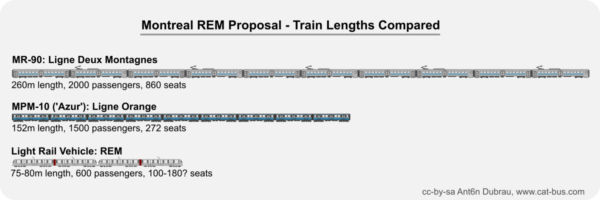
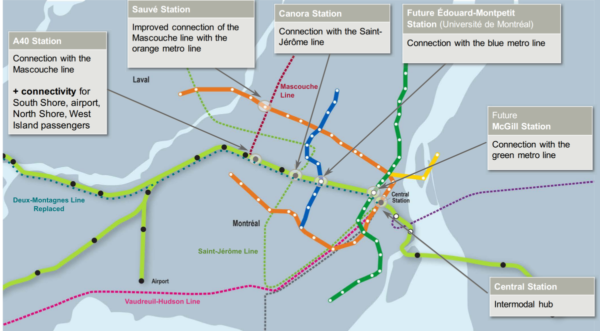
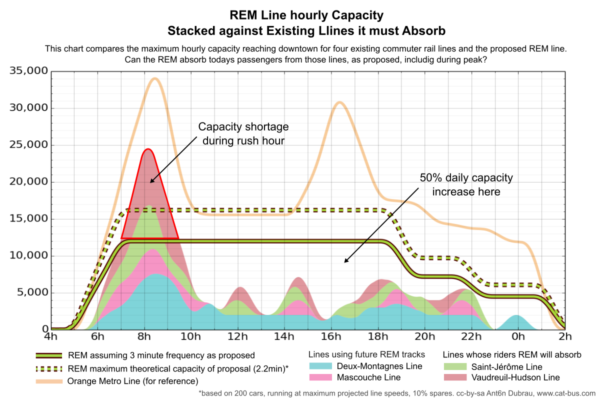
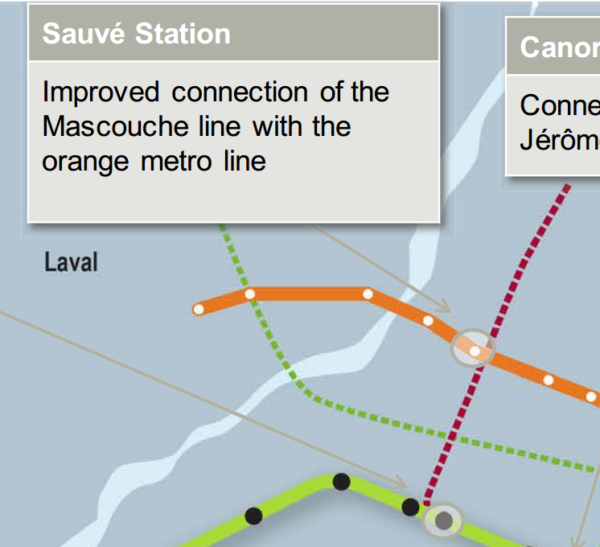
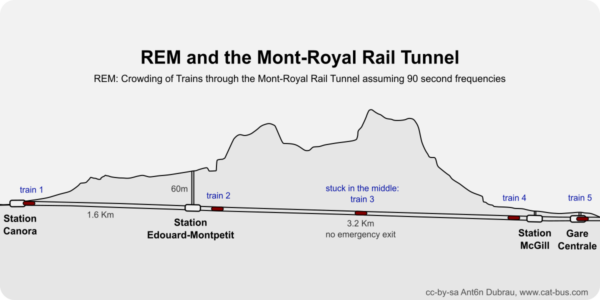
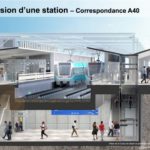
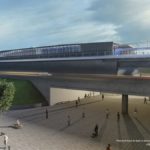
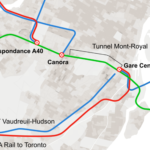
May 18th, 2016 at 09:24
How about if they built their stations with 120m platforms instead of 80m (6 car trains instead of 4 car trains)? Wouldn’t that solve most of the capacity issues and would be relatively simple to implement?
May 18th, 2016 at 09:36
@Benoit
I think they should go for at least 160m trains, but would prefer 200m trains for future proofing. But then we don’t have a “light rail” anymore. And we should stop talking about light rail, and just call it what it is: a Metro, a RER.
It’s true that increasing train lengths would be a relatively simple fix if done ahead of time. But then I wonder why the Caisse even proposed their system like this, why be so focussed on building a Skytrain here, why not build on what we have today? Are they really gonna build a system that’s gonna be at capacity from day one, and charge higher fares to ensure it’s not over-crowded, and dump people onto the Montreal Metro?
The incentives seem to be all wrong, so I worry that more obvious, glaring mistakes like these will come up as we learn more about the project. And some may even be intentional.
May 18th, 2016 at 11:34
Very detailed and well-written post! I think you’re right on almost all counts. The only thing I see missing here is a discussion of the huge increase in capacity off-peak and for reverse commuters. The proposed system provides an excellent link to two huge employment centres, the airport and Saint-Laurent, which are growing faster than downtown. If we ever build Edouard-Montpetit and the blue line extension, there will also be a good connection to the Anjou employment area, to say nothing of Brossard. As we shift towards a polycentric city and more flexible working hours, I would suggest that off-peak and reverse commuting headways become much more important.
That said, I would like to see longer trains and platforms.
May 18th, 2016 at 11:55
The difference between “light†and “heavy†rail is more to do with the ability to survive a collision with freight trains. The MR90 are designed to survive a collision according to AAR rules. This is why the max buff load in the specification sheet you link to is 800,000 lbs (CFR 238.203.a.1). By the way, the weight specification for the Hyundai Canada line trains is for the 2-vehicle train. Therefore the weight per m of each vehicle is a much more reasonable 926 kg/m. You can see that the MR73 fits in between these two values.
May 18th, 2016 at 12:44
It could be possible to keep running the Mascouche line trains into the tunnel.
You keep one track as it is, for mainline-sized trains, and the other track could be double-decked, exactly like the old CPR tunnel was double-decked for the Skytrain in Vancouver.
Or course, that precludes the use of bigger cars, which means that the stations will have to be planned for at least 10 car trains from the onset, because longer trains WILL be necessary at some point.
May 18th, 2016 at 13:27
@James
The weight spec is for a 2-car train, coupled pairs, which is 41m long. There’s nothing longer on the Canada Line, since the platforms are only 50m long. If you check the linked pdf, it puts the weight and length in the same table — why would one number refer to different lengths than the other. 1T/m would only be possible with extremely light streetcars, not high-platform, metal-shell, 3m wide subway cars.
@emdx
It would be much easier to just use trains that are compatible.
As for crash-worthiness, it’s not that important. There will be no freight on the REM, so the only thing that matters is collisions with other commuter trains. This could at least be partially mitigated with good signalling systems and positive train control. All of these things will be necessary when moving towards automation anyway.
May 18th, 2016 at 13:39
And just in case someone thinks there is a uniquely Canadian inability to run trains every 90 seconds: the busiest line of London Underground is currently running every 105 seconds. There are plans to get this to 36 trains per hour (every 100 seconds) but even that requires extra construction work to allow more passengers to exit stations faster.
Of course the London trains and stations are much longer and therefore the lines have a higher PPHD, which is the real issue with this plan.
May 18th, 2016 at 14:22
I agree there is a real danger for overcrowding given that the Deux-Montagnes rush hour trains are already overcrowded…
As for the other commuter lines, apart from Mascouche, I am not sure you can easily add up:
* For Vaudreuil-Hudson: sure if that line disappears everybody needs to move, but that would inconvenience a lot of people and the capacity just isn’t there as you noted. For rush hour trains I suspect most current VH users would keep on using it (those living closer to the 20 than the 40, everybody off-island, and those who need to get off at Dorval, Montreal-Ouest, or Vendome (including many high-school kids — e.g. Loyola, Royal West, Villa Maria).
The REM would take over much of the 470 and 485 STM buses however.
* For Saint-Jerome, many get off at De la Concorde, Parc, Montreal-Ouest, even Vendome and would not change to the REM. Did you exclude those?
May 18th, 2016 at 14:23
Another problem with the automated light rail option is that it precludes any future development by other rail agencies. VIA will need using the tunnel for its planned high-frequency service from Montreal to Quebec City on the north shore of the St.Lawrence (thus avoiding CN’s congested main line on Victoria Bridge). AMT would also love rerouting the St-Jérôme line through the tunnel to reach Central Station, and has planned so for several years. And AMT certainly would like to retain the Mascouche line through the tunnel as well, without its downtown link, that line is dead.
Better retain the existing technology and improve signalling (CBTC, PTC) to run fewer but higher-capacity heavy-rail trains that can mix with each other, thus maximizing the use of the existing network and allowing for its future growth.
May 18th, 2016 at 15:19
I think some of the points made about peak capacity are interesting. Nevertheless, I think light rail is the best solution for low-density suburban networks. It must of course be capable of increasing significantly train capacity and frequency at peak periods. I had not realised that the proposed trains were so short. I hope that the consultants to the Caisse have simulated the situation adequately. I also hope that differential pricing at peak periods will be applied to mitigate the problem.
Compared to the many other suburban rail systems I have used the Montreal one is remarkable for the quasi-absence of trains outside the peak periods. All others I have used (Dublin, Barcelona, Oporto, Copenhagen, for example) provide a minimum of 15 minute service outside peak times. A frequent service would allow people with flexible schedules to delay leaving home and returning in the evening, thus flattening the demand curve and relieving peak pressure. Peak pricing and crowded trains may also help to stimulate greater working time flexibility.
May 18th, 2016 at 16:19
@CedarPark
I don’t think it’s unfair to assume, in a relatively simple mode, that basically everybody will transfer from the St-Jerome line onto the REM to go downtown. Yes right now most people use de la Concorde, and many people use Parc, and some even sit and wait to reach Lucien l’Allier. But the travel time on the REM will blow that all out of the water.
As for VH, yes it’s unclear how many people will switch. But many people will, it’s exactly the project West Islanders have been waiting for — it’s either this or improved service on VH. So maybe not everybody will switch, but many will.
Even if you consider that only half the capacity from those lines will be needed on REM, we still have quite a shortage. If then we assume there will be induced demand, that people will switch from cars, that people will move to those areas, that people will switch from bus lines, that we also need to accomodate most people who come from the Blue Line, I think it should be obvious that the proposed capacity is beyond inadequate.
May 18th, 2016 at 16:24
@David
“light rail is the best solution for low-density suburban networks.”
I disagree. I think the best solution for suburban networks is rapid transit using relatively large trains that run at fixed, reasonable intervals. For example a fixed schedule of 15 minute throughout the whole day. Trains can be shorter during the off-peak. All the suburban train lines should merge downtown into a super-high capacity trunk line, which connects to all sort of transit, to all sort of jobs, and is basically a subway by itself. This kind of system is tried and working all over Europe, and has many names: RER, S-Bahn, Crossrail, S-Trog…
May 19th, 2016 at 09:09
Good article !
But two things:
1 – The caisse’s slides show 6 to 12 minutes on each of the 3 branches, so I think they already plan to have a 2 minutes interval in the trunk. And yes, the south shore line also says 3 to 6 minutes, so one can wonder how this two minute interval will turn into 3 minutes after gare centrale. My guess, some trains from the north will end at Gare Centrale while others continue to the south.
2 – Stating that the trains will not be faster based only on empty weight / meter is quite a simplification … There are many motorisation options out there. A light structure set on 10 motor-bogies might end up being as heavy as a heavy structure on 5 motor bogies + 5 passive bogies, but the former will be much more powerful than the latter for the same weight and have much better acceleration capacity. The weight of the passengers themselves shouldn’t be ignored either. In this example : http://www.ferro-lyon.net/nouveau-tram/498-Les-Rames-Citadis-402 you add about 40% of the empty weight by putting in passenger. And you’ll fit more passengers / length meter in a wide “heavy rail†train than a narrow light rail train. Especially if the heavy rail train is double-deck.
Anyway, like you said, light rail refers to a range of technologies, but in my mind, it generally accelerates and brakes faster than heavy rail. The typical image that comes to my mind when speaking about light rail is actually a modern french tram. So powerful enough to get to high speeds in portions where it has 100% dedicated right-of-way, but still light enough to be able to brake and accelerate fast in sections where a crazy pedestrian might cross the track right in front.
But overall, we agree, this project just doesn’t work…
May 19th, 2016 at 09:33
Also, I’m still very worried about this deathtrap tunnel …
Here’s a crazy idea: leave the existing heavy rail network alone. Build the south shore REM like in the project, then, at Gare Centrale, build a new tunnel right along the existing one, until Edouard-Montpetit. Build exchange stations at McGill and Edouard-Montpetit. Build connections between the two tunnels every 250 m, so that they can be used as emergency exits for each other. (With huge fans that could be activated both ways, to keep the smoke in the tunnel that is not being used as the emergency exit).
At this point you probably ran out of money, but you have your south shore branch with a direct link to the blue line, new direct links to the blue and green lines from the train lines that go through the tunnel, you keep the existing tunnel’s capacity to accommodate heavy rail traffic, and people actually have a chance to survive if there is a smoke incident in either tunnels. Yay !
Then when you get more money: merge he west part of the blue line into the REM. The east part of the blue line now ends at Edouard-Montpetit, but who comes from the east and goes any further than Jean Talon anyways ? Maybe a few students ? Good for them, they can still get to the university directly. Reuse the cars for the extension of the blue line to the east.
To the west: extend the former blue line through Hampstead and Cote St-Luc, with a stop at Loyola Campus, then go to the airport along the existing VH tracks.
Sorry for the northwest branch. Actually, if that’s really useful, you can still do it pretty much the same way as the Caisse wanted to do it, except you use heavy rail cars that will be compatible with the existing Deux-Montagnes and Mascouche lines.
May 19th, 2016 at 14:10
@Gael
My point is that that ‘light rail’ lines may not be lighter than ‘heavy rail’, because they may be lighter in total weight only due to being shorter. My point is that a shorter train is not faster than a longer train made of the same vehicles. Yes it depends on the traction etc., and it’s true the the Deux-Montagnes train is partly relatively light because it has unpowered trailer cars.
But a train powered by 25KV overhead, which is 3.2m wide and high platform, will always be heavier than a French Tram. I think the French Tram image is what the Caisse is trying to convey to get people excited, but it doesn’t make sense to build that on a line that’s completely separated from traffic. And that’s not what they built for the Canada Line, which is a light metro – so it _is_ “light rail”. And those vehicles _are_ barely lighter than the Deux-Montagnes line trains.
Note that the Montreal Metro is ‘heavy rail’, and it has close to the fastest acceleration among any rail, be it heavy or light.
May 24th, 2016 at 12:04
You analysis is interesting but you factor too many traffic exchange with the AMT lines currently connecting to the metro system. I am sure this will be partially (greatly?) offset by a premium surcharge to discourage AMT pass-holders from transiting to REM before the trunk stretch.
Plus, as others have pointed out, you should also include in your analysis various factors that should contribute to the reduction of the PPHD on the trunk stretch, namely:
1) The REM will deserve substantial employment centres such as the Airport, St-Laurent technoparc, Kirkland, etc.: many passengers will get out before the trunk stretch.
2) The increase in hourly departures will flatten the peak hours PPHD.
3) The extended operating hours will allow some people to delay their work schedule (mostly downtown office workers trunk stretch passengers).
4) The Pix IX express bus + blue line Anjou extension should also redirect a certain amount of North-shore/North of 40 commuters to the green line. This should have a ripple effect on the Orange Line and the REM.
Let’s not forget that this project is far from being optimized…
May 25th, 2016 at 22:57
Very interresting.
I’d like to volunteer for a french version of this. Many french speakers in eastern Montreal are not aware of the impacts of this project and you explain them very well.
May 31st, 2016 at 03:21
I think the project would be a lot more viable if the Caisse rationalized the scope and focused solely on the West Island and Brossard spurs, which (I think) represent the primary constituencies of the improvements. (Technoparc could be adequately served from the West Island branch, and Alon Levy’s principle of improving mainline rail-airport connections first applies as much to Dorval; VH frequency improvements are needed on their own merit.) While the through-running would be revolutionary, the Caisse is committing the classic mistake of improperly pairing 3 branches with 1; the 3 combined create a ridership demand imbalance relative to Brossard, which, in stark contrast to the overburdened northern branches, probably has little demand for 90-second or even 3 minute headways. Keep the nominal “light rail” moniker if they must, but opt instead for articulated 4-car mainline-capable sets like the Stadler FLIRT with AC electrification and run it it as a tram-train, with compatible CBTC signalling. The resulting 1:1 branch pairing keeps operation simple for the Caisse, doesn’t overburden Mt. Royal capacity and tunnel egress outright, lets DM keep its necessary 2000-person trainsets, doesn’t cut off Mascouche access right when it needs to grow ridership and infill stations, and ultimately saves enormously on cost (especially pointless platform reconfiguration and electric conversion), which could be spent on a host of miscellaneous AMT/STM improvements. Organization before electronics before concrete. Ultimately the project, if properly implemented under mainline RER/S-Bahn standards, could serve as a pilot for reforming the entire AMT network with electrification and all-day frequency.
May 31st, 2016 at 10:06
@kclo3
I think you have the right idea. Although I tend to think that the northern branches (West Island, Deux-Montagnes, Mascouche … and eventually St-Jerome line?) should all run on fixed 4tph schedules eventually, interleaving to 20-24 tph if we include an occasional regional or long distance train through the tunnel. Matching the West-Island train to the Brossard train at this level would result in 4 tph in Brossard, which is a bit low. Maybe matching two lines would make more sense, that would give 8tph in Brossard.
In any case, keeping the existing system and trying to make it lighter is the way to go. Note that FRA compliant EMU trains are not so bad in terms of weight, and are decent to great in performance (M7, M8, silverliner 5, arrow iii). If we created, say, 70-80m articulated train sets from these trains, they’d be even lighter and better with performance, without having to worry about fighting regulations. Trains like this could run _everywhere_, in 1, 2 or 3 train consists.
June 1st, 2016 at 20:29
Hi, it’s good to have another view of this project, but where do you get a 2000 per train on DM line and 7000 pph? I see something more like 1200 per train, so 4800 pph (ok the line is fully loaded) according to La Presse (answers from AMT Ceo).
http://www.lapresse.ca/actualites/montreal/201509/11/01-4899508-train-de-deux-montagnes-un-confort-ameliore-dans-deux-ou-trois-ans.php
June 1st, 2016 at 23:42
MR-90 train has 80-92 seats, and allows 126 standing passengers. Let’s call it an even 200. Multiply by 10 cars, and you get 2000 people per train.
https://en.wikipedia.org/wiki/MR-90
The 7500 pphd is through the tunnel. Trains arrive as often as every 15 minutes, so 4tph. That number isn’t sustained for every long. Not also that those trains don’t all come from Deux Montagnes, some may come from Bois Franc. But the point is capacity through the tunnel. The source code for the the graph generation is linked near the graph (it’s in python).
July 23rd, 2016 at 10:54
Interesting ridership graphic. But I am having trouble with the data. Looking at the AMT 2015 annual report I get:
-30,400 passengers/day on Deux Montagnes
-15,800 passengers/day on Vaudreuil-Hudson
-13,200 passengers/day on Saint-Jerome
-6,400 passengers/day on Mascouche
-65,800 passengers/day Total
So if we assume 85% of trips are during the peak period and in the peak direction we get: 55,930. Then we assume 55%-45% AM/PM trip distribution we have: 27,965 passengers/3h morning peak. Then we assume 45% of those trips are in the peak hour we have 12,584 passengers/h in the peak direction (pphpd).
I agree with the 12,000 pphpd capacity, but I would bet a maximum 85% transfer from all lines but Deux-Montanges could be achieved. That would mean it would run at capacity. Of course that also means we can truncate Saint-Jerome at Canora and disband Vaudreuil-Hudson.
Even though it is so close I think the REM would cannibalize at most 50% of the Vaudreuil-Hudson ridership since off-island commuters avoid bridges and Dorval, Lachine, Montreal-Ouest have no good access to REM and a number of commuter like the train. Which means some capacity remains.
I share the concern with what happens when a Mascouche line train terminates at A-40, this will not be pretty.
My 2 cents.
July 23rd, 2016 at 11:37
@TransitGuy
You make a lot of assumptions, and the back-of-the-envelope calculation is probably what the Caisse guys did for their ‘ridership study’ that they won’t publish. The problem is two-fold:
– You underestimate the peakiness of the required capacity.
One way to model it is to look at the distribution of trains in the schedule — presumably over the last twenty years, the AMT has adjusted the schedule to fit exactly the requirements it needs. And in a way, the distribution may be even more peaky, because there’s a mininum frequency that trains can run with at this point (i.e. trains during the peak-peak may be fuller then otherwise).
– You compare today’s actual ridership on the one hand with crush-capacity on the other.
By calling my graphic a ‘ridership-graphic’ rather than a ‘capacity-graphic’, you show your confusion. By confusing ridership and capacity, you basically assume that today’s train system has more than 50% extra capacity when trains are at actually at crush load during the peak time. You cannot simply plan that way, you cannot assume you can somehow distribute everybody who physically takes the train today and distribute them over several hours at crush-load in the future. And then ignore ridership growth on top of that (consider that when the Deux-Montagnes line was rebuilt, it quintupled within a couple of years).
The comparison of today’s capacities to future capacities is much more appropriate, even if it is a bit of a simplification.
Regarding the Vaudreuil-Hudson line, yes it’s unclear how many people will switch. Right now the VH line has about 16,000 trips, the REM plan assumes 10K on the west island branch and and 10K for the airport. The west island ridership seems like quite an under-estimate, because just the 470 bus by itself has around 10K people coming from fairview.
Regarding the Mascouche line, it will have 11K trips in a couple of years. It could quadruple that if it was upgraded to serve people in Montreal North and East. The current REM capacity plan essentially relies on the Mascouche line staying crippled.
September 12th, 2016 at 10:40
Why is it that we in Montreal have to change our transit differently to every other city of the same size. Why not look at other cites that are the same size or larger like Toronto and New Jersey and even European cities. They all use the existing network rails to extend the capacity. Take for example Paris, with the extensive RER network within the city, it is not built with metro style infrastructure but with ‘heavy’ rail and double deck stock. Extending what exists is always cheaper than building new. Even if new heavy rail has to laid for missing segments I would think it would still be cheaper than replacing what exists.
As for the new Champlain bridge the REM could be built there with transfer a Central station, but make the trains longer.
September 22nd, 2016 at 18:39
Hi,
http://www.lapresse.ca/actualites/montreal/201509/11/01-4899508-train-de-deux-montagnes-un-confort-ameliore-dans-deux-ou-trois-ans.php
Here they are saying that the Deux-Montagnes trains carry 15,000 passengers (around 50% of the daily total) during the morning peak hours (6 to 9 AM I suppose).
Doing the same math on the Vaudreuil (15800 pass per day) and Mascouche (6400 per day) lines you end up with 25,100 passengers during peak hours from the A40 station to Gare Centrale. Incorrectly assuming that 100% of the passengers of these lines would use the REM.
It appears that there is no more plans for a Saint-Jerome line connection.
With one train every 3 minutes (during rush hours) the REM could carry 36,000 passengers in 3 hours.
Concerning the A40 station, empty REM trains would be inserted between the ones coming from the west to facilitate transfer.
October 9th, 2016 at 00:30
@Calvin
Half the peak ridership is during one hour. So the 25,100 people will mean 12550 people during the peak hour. This doesn’t include the St-Jerome line anymore, it doesn’t include additional ridership from the DM line, and doesn’t consider the Blue Line, and doesn’t allow the Mascouche line to increase ridership to the its planned levels, or it’s potential levels.
The 3 minute frequencies that this project was initially proposed with is not enough. Once you move to 90 seconds it’s better — but we still have the problem that between Deux-Montagnes and Roxboro, capacity won’t increase (and that seating will significantly reduce), and that we are forcing a bunch of transfers on the users of the various other lines.
June 16th, 2017 at 11:11
Vancouver’s SkyTrain is actually a classic light metro and not light rail. One of the classic definitions of LRT is that it must be able to operate in mixed traffic (on-street) and with Vancouver’s SkyTrain being automatic and driverless, it cannot operate in mixed traffic.